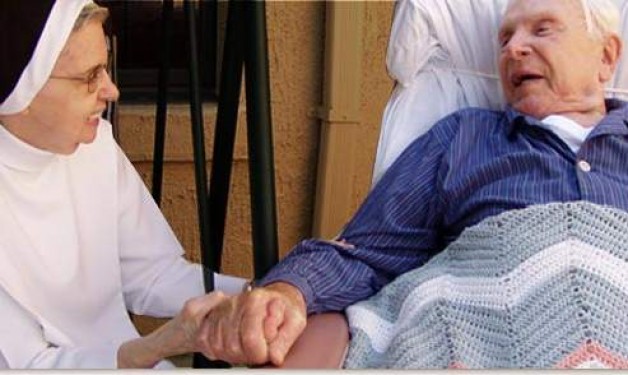The Gospel of life is at the heart of Jesus’ message. Lovingly received day after day by the Church, it is to be preached with dauntless fidelity as “good news” to the people of every age and culture.
—Bl. John Paul II, Evangelium Vitae (§1)
In January, hundreds of thousands of people from all over the United States gather in the nation’s capital to march in defense of the lives of the unborn. About a week before this year’s annual March for Life, friars at the Dominican House of Studies in Washington, D.C., gathered to watch a documentary on another issue related to the Gospel of life. How to Die in Oregon (2011) is a powerfully somber and emotionally stirring account of the lives of individuals, families, physicians, politicians, and many others affected by the 1994 legalization of physician-assisted suicide for those with terminal illnesses.
The film inspired the friars to discuss ways in which we could preach the Gospel to people so intent on having the power to control their lives, to use the words constantly repeated by those interviewed in the film. I was truly inspired by my brothers, Gospel men wanting to faithfully follow in the footsteps of our Holy Father St. Dominic in the twenty-first century. One brother brought up the idea of a response film, or at least a documentary on Catholic end-of-life care.
Following this suggestion, the work of the Dominican Sisters of Hawthorne immediately came to mind. I had heard so many good things about the wonderful work of our sisters from some of the brethren who had worked with them before, and now I have been blessed to be with them this summer at their home on Rosary Hill in Hawthorne, New York.
The Dominican Sisters of Hawthorne are a congregation of Dominican sisters founded in 1900 by Servant of God Rose Hawthorne (Mother Mary Alphonsa), the daughter of Nathaniel Hawthorne. Their mission is to care for people diagnosed with incurable cancer who cannot afford to pay for their own care. Although the sisters constantly deal with the inevitability of death, an appropriate title for a documentary about their work would be How to Live at Hawthorne. It is in the face of death that we see their fidelity to the Gospel of life.
Much could be documented in a film on the Hawthorne Dominican Sisters. There would definitely be a retelling of the rich history of the congregation. Interviews with the sisters, patients, families, volunteers, resident chaplain, and benefactors are a must-have. Sister Mary Edwin pushing a pill cart down the hallway sounds like a good idea for an action scene. But if I were to have a say in the production of the film, I would focus on the liturgical life of the sisters. Their love of Jesus is the very heart of their care for the terminally ill. This is what makes their apostolate more than simply patient care.
The sisters have a special devotion to the Sacred Heart of Jesus: their home in Philadelphia is named for it, and the sisters here at Rosary Hill Home in Hawthorne pray a daily litany in the Sacred Heart’s honor. The special charism of the sisters seems to be founded on the Sacred Heart of Jesus because it is through His Most Sacred Heart that not only the sisters but also the patients find their true life support. Virtually everyone here speaks highly of the quality of patient care at Rosary Hill, but that’s not all the patients receive. Most importantly, they are given daily doses of God’s eternal love, of His promise of everlasting life.
Anyone who has been to Rosary Hill for the last three years knows a man named Bob. Some thought he wasn’t going to make it very long when he first arrived—a couple of weeks, maybe. But as soon as he got here, things started to change. The sisters welcomed Bob into their home; he became part of the family. They loved him. They spoiled him with smoothies. He became healthy again and was so active that people thought he was a volunteer. He met regularly with the resident chaplain and eventually converted to the Catholic faith and reconciled with his family after many years of alcoholism. It was like he was a new man—that he had a new life. Bob died just a few weeks ago, and we pray that the newness of life he experienced at Hawthorne will bring him to eternal life with God in heaven.
Covered with the love of the sisters, staff, and volunteers, patients here seem to be filled with divine charity in their own hearts. The words spoken by the prophet Ezekiel about God putting into us a new heart and a new spirit (36:26) come alive in a special way at Hawthorne.
It is through Jesus’ Sacred Heart that we are able to live on in spite of difficulties. All of us will pass through death, but those who die in Jesus will be raised to life again. Isn’t this the heart of the message of the Gospel: eternal life in God rather than death in sin? As Bob wrote in his journal, cancer was the best gift that God had given him because it gave him back his life.
By the witness of their lives, the sisters help the patients to accept the gift of God’s loving providence and prepare for eternal life rather than to seek the power to control their lives here on earth. For this reason, we often hear them say, “This place is like heaven before Heaven.”
✠







